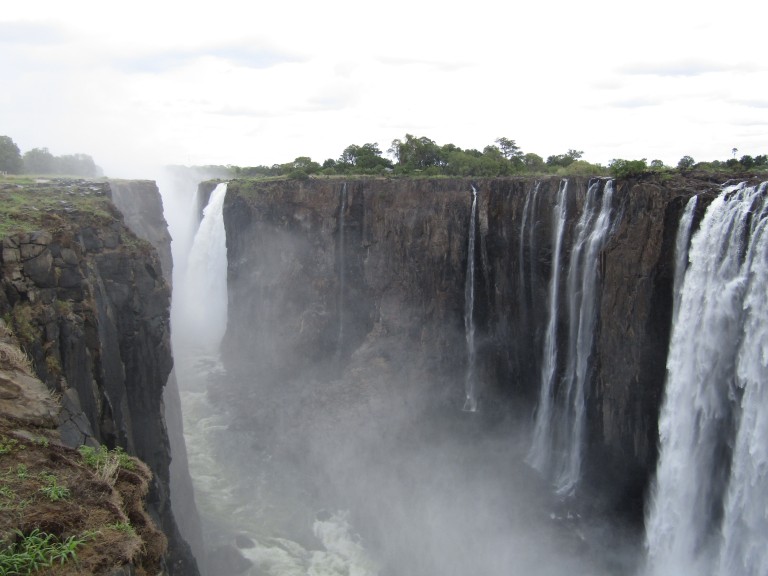Jared McDonald (University of the Free State, South Africa), author
On 15 January 2016, I had the pleasure of travelling to Livingstone, Zambia and Victoria Falls Town, Zimbabwe, as a representative of Livingstone Online. This visit was in response to an invitation by the Jafuta Foundation, a non-profit organisation based in Victoria Falls Town. The Foundation seeks to promote and facilitate collaboration between communities, the private sector and local authorities in the interests of wildlife and heritage conservation, education and community development.

The priority of the visit was to continue discussions with the Livingstone Museum concerning the digital preservation of their original Livingstone manuscripts. The Livingstone Museum, located in the town of Livingstone, Zambia, is the oldest museum in the country, having opened in 1934. It houses one of the largest collections of original Livingstone materials in Africa. Formerly named the Rhodes-Livingstone Museum, the museum changed its name in 1966 in order to emphasize the importance of David Livingstone in the history of the area and to spotlight the fondness with which he is remembered by local communities. In recent years, efforts have also been made to remember the assistance Livingstone received from Africans while on his travels and explorations, as reflected in the following image.


Contact with the Museum director, George Mudenda, had already been initiated by Jafuta Foundation trustee, Gail van Jaarsveldt, who first learned of Livingstone Online while watching the National Geographic documentary, The Lost Diary of Dr. Livingstone. Gail was aware of the rich collection of original Livingstone documents housed at the Livingstone Museum and contacted Livingstone Online’s director, Adrian S. Wisnicki, to inquire about the possibility of digitizing the Museum’s Livingstone records. This led to an invitation to visit.
As the project lead in southern Africa, I was the closest member of the Livingstone Online team to the site of the action and gladly agreed to Gail’s invitation. What unfolded was an extraordinary visit, thanks in large part to the generosity of the local inhabitants of Livingstone and Victoria Falls Town who actively seek to preserve the memory of David Livingstone.

Setting out in the footsteps of Livingstone began in earnest on Tuesday, 16 January. Following a productive meeting with the Museum Director, George Mudenda, and several other staff members who work closely with the Museum’s archival records, I was invited to join two local Livingstone enthusiasts on a boat trip up the Zambezi River.
Among the many beautiful sights we encountered along the way was Kalai Island. Once a Leya settlement, the island is also home to the burial ground of four Leya kings, including Chief Sekute. Livingstone camped on Kalai Island on 15 November 1855, the day before he first sighted Mosi-oa-Tunya, which he later named Victoria Falls. Livingstone describes the burial site of the Leya kings as being surrounded by a wall of seventy elephant tusks. Sadly, this no longer exists, but the island remains an important cultural, historical, and archaeological site.


I returned to the Livingstone Museum on Wednesday, 17 January, to spend more time examining the original Livingstone documents. It is always a privilege to handle Livingstone’s original letters and notes – especially to bring them out of their boxes and sleeves, often for the first time in many years. It soon became apparent that there is a sizable number of letters contained in the collection that were unknown to Livingstone Online – a very exciting development indeed!

The following day, I was treated to a tour of Victoria Falls by local guide, Mark Geraghty. Mark’s enthusiasm for preserving the memory of Livingstone, as well as the geological and social history of the Falls, is contagious. He is but one of a merry band of Livingstone aficionados who provide insights into the life of the famous missionary-explorer to a steady stream of tourists visiting one of the world’s natural wonders.
Though the amount of water flowing over the Falls usually reaches its height in April, we were still drenched from the spray that rises into the air above the mighty crevice that swallows up the Zambezi River. A statue of David Livingstone stands above the Devil’s Cataract, on the western edge of the Falls.


On 16 November 1855, Livingstone travelled the eight miles south of Kalai Island aboard a canoe. Upon reaching an island just above the centre of the Falls, he crawled towards the fissure on his belly, eventually gazing over the precipice and securing his place in history as the first European to view Mosi-oa-Tunya. It is not hard to see why Livingstone described the Falls as the most wonderful sight he had witnessed in Africa.

Friday, 15 January, marked the end of my week’s travels in a very special part of the world. Apart from the privilege of getting to work with the Livingstone Museum’s rich collection of original Livingstone documents, my expedition was made all the more remarkable by the many individuals who shared their knowledge of Livingstone, the Falls, and the region with me. New opportunities for collaboration in southern Africa have emerged and I look forward to what this new phase of the project holds.

2 thoughts on “In the Footsteps of David Livingstone: Exploring New Opportunities for Livingstone Online in Southern Africa”